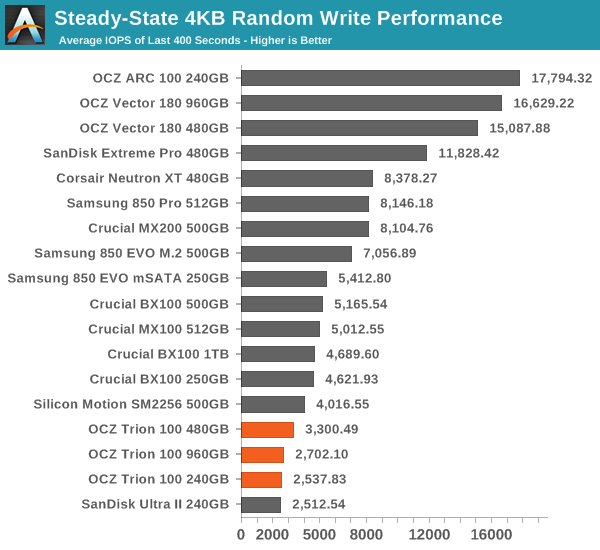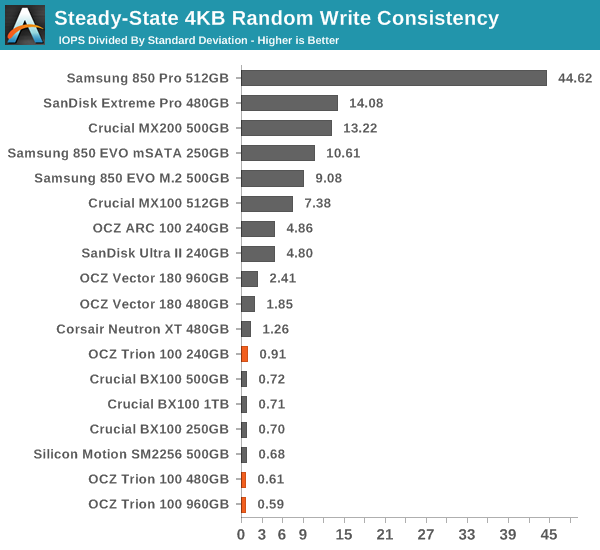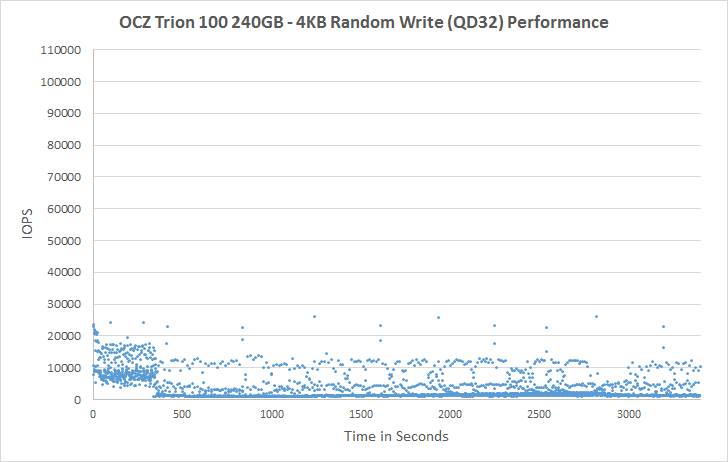OCZ Trion 100 (240GB, 480GB & 960GB) SSD Review: Bringing Toshiba to the Retail
by Kristian Vättö on July 9, 2015 12:01 PM ESTPerformance Consistency
We've been looking at performance consistency since the Intel SSD DC S3700 review in late 2012 and it has become one of the cornerstones of our SSD reviews. Back in the days many SSD vendors were only focusing on high peak performance, which unfortunately came at the cost of sustained performance. In other words, the drives would push high IOPS in certain synthetic scenarios to provide nice marketing numbers, but as soon as you pushed the drive for more than a few minutes you could easily run into hiccups caused by poor performance consistency.
Once we started exploring IO consistency, nearly all SSD manufacturers made a move to improve consistency and for the 2015 suite, I haven't made any significant changes to the methodology we use to test IO consistency. The biggest change is the move from VDBench to Iometer 1.1.0 as the benchmarking software and I've also extended the test from 2000 seconds to a full hour to ensure that all drives hit steady-state during the test.
For better readability, I now provide bar graphs with the first one being an average IOPS of the last 400 seconds and the second graph displaying the standard deviation during the same period. Average IOPS provides a quick look into overall performance, but it can easily hide bad consistency, so looking at standard deviation is necessary for a complete look into consistency.
I'm still providing the same scatter graphs too, of course. However, I decided to dump the logarithmic graphs and go linear-only since logarithmic graphs aren't as accurate and can be hard to interpret for those who aren't familiar with them. I provide two graphs: one that includes the whole duration of the test and another that focuses on the last 400 seconds of the test to get a better scope into steady-state performance.

TLC SSDs in general don't perform well under sustained random workloads and the Trion 100 is no exception. It seems that with TLC SSDs we have to accept a drop from 5K to 2-3K IOPS, which is still fine for basic client workloads since most SSDs from 3-4 years ago couldn't even match that.

The consistency isn't great either, but it's not particularly poor either when compared agains Silicon Motion drives.
 |
|||||||||
| Default | |||||||||
| 25% Over-Provisioning | |||||||||
Looking at the performance over time, we can see that the baseline performance hovers at about 1,000 IOPS with frequent peaks occuring at 5K to 10K IOPS. That's actually very similar to the Neutron XT's (Phison S10) graph because the baseline is also 1,000 IOPS, although the peaks are higher and more frequent, but it further reassures that the underlying firmware architecture is similar. Increasing over-provisioning doesn't increase the baseline performance, but it does make peak performance moments more frequent and higher (from 10K IOPS to 25K IOPS).
 |
|||||||||
| Default | |||||||||
| 25% Over-Provisioning | |||||||||










65 Comments
View All Comments
harrynsally - Tuesday, July 21, 2015 - link
I always wondered why no other company bid on the OCZ bankruptcy assets. Toshiba was the only bidder. Now we learn............"Toshiba president Hisao Tanaka and his predecessor Norio Sasaki resigned on Tuesday over a $1.2 billion accounting scandal blamed on management's overzealous pursuit of profits"
"It has been revealed that there has been inappropriate accounting going on for a long time, and we deeply apologise for causing this serious trouble for shareholders and other stakeholders," said a company statement.
http://www.msn.com/en-us/money/companies/toshiba-p...
yefi - Tuesday, July 14, 2015 - link
I thought Toshiba acquired OCZ for the expertise. Instead, the only thing they seem to be using is the brand label - a brand connoting unreliability and deceitfulness. High-fives upper management!creed3020 - Wednesday, July 15, 2015 - link
Thanks for another great review Kristian. It is always good to see the full spectrum of what exists in the SSD space, and let the results do the talking.I'm still not seeing major advantages over the Crucial MX100 512GB in many cases when it comes to high capacity, great performance, and good value.
I expect more from OCZ when I see that name. My OCZ DDR memory sticks are a reminder of that bygone era.
deadlockedworld - Tuesday, August 18, 2015 - link
Hi folks. Now that the price of this drive has dropped to $279 its looking more attractive as a budget drive. Do we think that there is a possibility that firmware updates would improve its performance over time? Thanks.cbjwthwm - Friday, September 25, 2015 - link
New firmware (11.2) was just released which addresses the high latency issues on heavy loads, which should improve performance (and possibly power consumption as well) in the "The Destroyer" section of these tests where it performed particularly badly.The firmware version format seen on these drives is pretty obviously a Phison S10 controller, so hopefully OCZ can apply their expertise at low latency firmware design from the Barefoot-based products to this architecture and hopefully Phison-based products in general. Barefoot-based drives unfortunately can't really be recommend in general for mobile use because of their high power consumption, so this teaming of OCZ and Phison has some potential (like Intel and Sandforce in their SSD products) for improving the market in general.